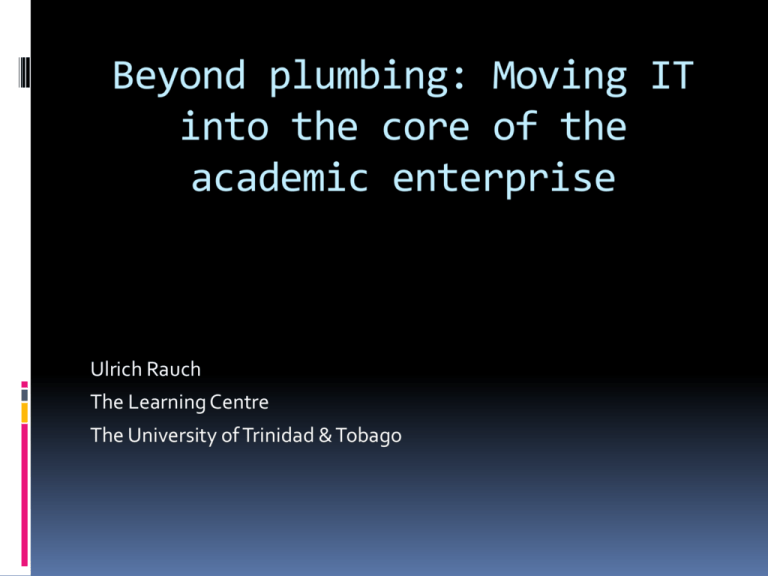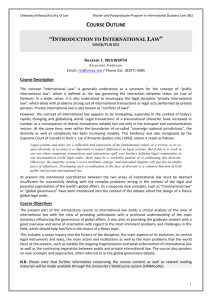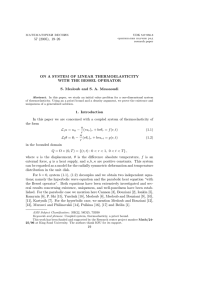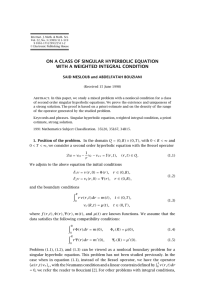Student Perceptions of Using Facebook as a Learning Tool in an
advertisement

Beyond plumbing: Moving IT into the core of the academic enterprise Ulrich Rauch The Learning Centre The University of Trinidad & Tobago Coming of Age … … a story of psychological and organisational growth from youth to adulthood …. large technology departments slow the progress of mankind 4 Mr. Mossberg touched a nerve when he called information-technology departments of large organizations, including colleges, "the most regressive and poisonous force in technology today” http://chronicle.com/article/The-Most-Poisonous-Force-in/17655 There is a widespread recognition that information technology has become a strategic enabler of the core academic mission Enterprise-wide administrative Systems; Human Resources; Finance; Student Information Systems; Intranet; Learning Management Systems; Library Systems Historically, Universities separated “computing as an infrastructure service” from “academic computing”, understood as supporting teaching, learning and research • Core IT capability is now in place . • Core business of the university is education and research 9 “Research and education, the core missions of colleges and universities … rely on IT to advance the frontiers of scholarship and to perform the essential work of higher education institutions”. M. McRobbie and B. Wheeler, Educause Review, Vol 45, #3, 2010 Computer Lab at Virginia Tech Emory University, Cox Hall UTT Computer Science Lab UTT Video-Conferencing with remote instructor Just before an airplane breaks the sound barrier, sound waves become visible on the wings of the plane. The sudden visibility of sound just as sound ends is an apt instance of that great pattern of being that reveals new and opposite forms just as the earlier forms reach their peak performance. Marshall McLuhan: Understanding Media; P.12; Mentor, New York, 1964 Top-Ten IT Issues 2008 1. Security 2. Administrative/ERP/Information Systems 3. Funding IT 4. Infrastructure 5. Identity/Access Management 6. Disaster Recovery / Business Continuity 7. Governance, Organization, and Leadership 8. Change Management 9. E-Learning / Distributed Teaching and Learning 10. Staffing / HR Management / Training Source: Educause Current Issues Survey 2008 Top-Ten IT Issues 2011 1. Funding IT 2. Administrative/ERP/Information System 3. Teaching and Learning with Technology 4. Security 5. Mobile Technologies 6. Agility/Adaptability/Responsiveness 7. Governance, Portfolio/Project Management 8. Infrastructure/Cyberinfrastructure 9. Disaster Recovery / Business Continuity 10. Strategic Planning Source: Educause Current Issues Survey 2011 ??? IT Governance as we know it is dead … Moving IT from simple technology management to strategic partner and catalyst for transforming higher education requires: shared leadership that emphasizes seamless collaborations across (academic and corporate) silos Aligning IT activities to the mission of the institution … Strategic Planning of IT focused on needs of Academic community IT Leadership and Academic leadership walk hand in hand Indiana University; University of British Columbia; Penn State; UCLA, Wisconsin IT Governance at Pepperdine University http://campustechnology.com/articles/2011/0 8/01/innovators-pepperdine.aspx I suggest that there is a need to shift the locus of strategic planning for the use of information technology from the Office of the CIO Information Technology Services to the Provost's Office, or at a very minimum, deeply involve the academic side of the house Source: Joshua Kim, BlogU, , Sept. 6, 2010 Campus Technology leaders … before and after. This change in leadership positioning is set up to enable academic leadership to engage other key stakeholders -- internal and external -- to ensure that the academic enterprise is enabled with information technology. Democratization: As the separation of expert technologist and expert technology user becomes more fuzzy, --- thanks to the ubiquitous availability of digital technology --- it becomes increasingly evident that looking at the mandate of IT on one hand and academic computing on the other, there are many synergies to be exploited Economics: Sharing staff/ skills Closer alignment of IT and Academic computing allows the exploration of synergies Opportunity for cost reduction while simultaneously improving relevant service delivery Analytics: Collection of data from all enterprise wide systems for comprehensive decision making An early warning system allow us to provide learners with insight into their own learning habits and recommend ways of improvement ITS Ac. comp . 1. IT participates in the institutional strategic planning process – academics are participating in IT decision-making -inclusiveness 2.VP IT/T&L to be an academic appointment – shared governance. 3. IT broadens its exposure and redefines its mandate from infrastructure provider to a competent partner of all things academic – strategic enabler Thank You! ulrich.rauch@utt.edu.tt











